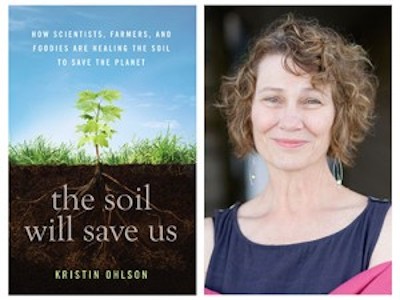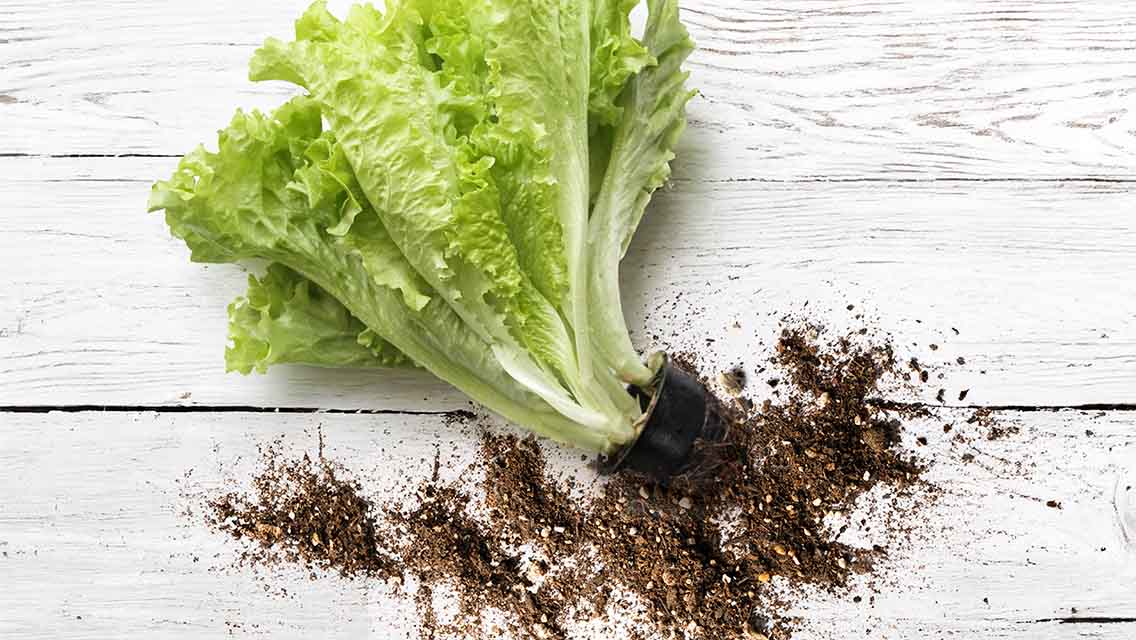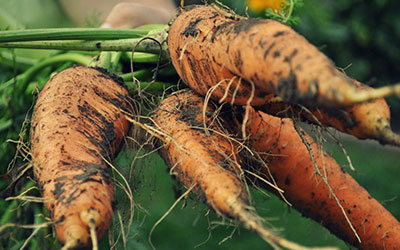Healthy soil can reverse global warming. That’s the big, new idea behind Kristin Ohlson’s fascinating book, The Soil Will Save Us: How Scientists, Famers, and Foodies Are Healing the Soil to Save the Planet, which is being published today by Rodale and is already garnering praise from critics and thinkers (including Michael Pollan, who tweeted about it).
Ohlson, a journalist and New York Times bestselling author, is also a frequent contributor to Experience Life. She talked with us recently about the critical connection between the health of our soil and the health of our planet.
EL | What is the relationship between the loss of carbon in the soil and the excess carbon dioxide in the atmosphere?
Most people think that the overload of carbon dioxide in our atmosphere comes exclusively from the burning of fossil fuels, but that’s not true. People began adding CO2 to the atmosphere thousands of years ago through the ways they used the land. We tend to think that ancient people left a lighter footprint on the land than we do, but that’s not true. There were fewer of them, but their accumulated activities over thousands of years may have warmed the climate so much that we missed an ice age that would have occurred 2,000 years ago.
One way that they added CO2 to the atmosphere was by plowing. There is nothing in nature that opens up the soil to that depth with such regularity, and it exposes the carbon to oxygen so that it forms carbon dioxide.
How did that carbon get in the soil? It had been accumulating there for millions of years before mammals evolved, through a partnership between plants and the microorganisms in the soil. We can’t see them with the naked eye — and we had no idea they were there until fairly recently — but the earth beneath our feet is teeming with tiny creatures. There are an incredible six billion microorganisms per tablespoon of soil. The partnership between these microorganisms and plants have created the basis for just about all life on earth.
Here’s how it works. Plants remove carbon dioxide from the air through photosynthesis and convert it into carbon-based sugars and protein to fuel their growth. But plants only use about 60 percent of this carbon-based food themselves. The rest of it is sent down to their roots, where the microorganisms cluster like pigs at a trough. The roots ooze out a carbon meal for the microorganisms. In turn, the microorganisms leave behind mineral nutrients the plants need, which they’ve liberated from sand and rock.
That carbon cycles through the soil, as the microorganisms both eat it and use it to build tiny structures for protection and to hold water. Finally, the carbon is “fixed” in the soil, semi-permanent, until hit by a disturbance like plowing.
EL | Up until the 1950s, you write, “most of the excess carbon dioxide in the air resulted from the ways humans use their lands and forests. Currently, “land misuse [still] accounts for 30 percent of the carbon emissions entering the atmosphere.” What are the ways in which we currently misuse the land and release carbon into the air?
Most agricultural lands are still plowed — and today’s plows are more powerful and plunge deeper than those of our forebears. Land is also disturbed for urban development. Any time land is cleared of vegetation and left bare, the carbon at the surface will oxidize and become carbon dioxide. Fires also send huge amounts of carbon dioxide into the air and, in many parts of the world, forests are burned to create new agricultural land.
EL | There are currently many technologies afoot to reduce the amount of carbon dioxide our modern lifestyles produce, such as fossil fuels, wind energy, and solar energy. As important as those are, “none of these,” you point out, “will actually reduce the legacy load of carbon dioxide already in the atmosphere.” What can restore carbon to the land and reduce that load, as you’ve mentioned, is photosynthesis. Can you describe how this is being put into practice by scientists and farmers?
Many scientists and farmers are now working to maximize the carbon-fixing partnership between plants and soil microorganisms. They’re trying to disturb the soil as little as possible — for example, shifting from plowing to no-till agriculture (in which just a tiny slit is made in the soil to receive seed, then pinched shut). They’re mimicking nature and increasing the diversity of plants above ground so as to feed a greater diversity of soil microorganisms under ground. They’re figuring out new ways of making compost that creates super healthy soils. And they’re grazing animals in ways that mimic the behavior of ancient herds to make the soil even healthier.
EL | Given the importance of soil health to our planet’s health, why don’t we know more about this? Also, what are some of the most heartening signs of progress?
Soil is really the hidden kingdom — the last frontier. Until fairly recently, it was impossible for people to see the tiny life forms in the soil. And even when scientists began calculating how many of them are there, it took a while for them to figure out why the microorganisms are there and how important they are to life on the planet.
Here’s a good comparison: in the last few years, we’ve all started to hear about the microbiome, which is the community of microorganisms that live inside our bodies and is critically important to our overall function and health. There are about ten very tiny microbial cells to every human cell. That microbial mass weighs several pounds by the time we’re adults and is considered to be much like an organ, in terms of its importance. But we knew nothing of this a few years ago!
Similarly, we were pretty clueless about the microbial community in the soil until just a few years ago. There is now a growing understanding that the soil beneath our feet is teaming with life. It’s clear that the vigor of that community of microorganisms affects everything from the nutritional quality of our food to the health of our waterways to our ability to withstand both floods and drought to global warming. Around the world, farmers, ranchers, scientists, environmentalists, urban gardeners, and others are now trying to understand how to enhance the natural relationships in Nature to create healthier landscapes.
EL | How can everyday folks help to save the soil?
Many ways!
1. As much as possible, buy sustainably raised or organic food from local producers. Many small farmers and ranchers have gotten the message about soil health and are already taking steps to make sure they are enhancing the partnership between plants and soil microorganisms. They’re making the land healthier. Industrial farming just keeps making it sicker.
2. Build your own soil health! Eighty percent of American homeowners have a yard. You can build soil health there by increasing the diversity and abundance of the plants in your yard. Make sure every bit of ground is covered by either live or dead plants, so the microorganisms have some sort of carbon to eat. You can even make the soil under your lawn healthier by using seed mixtures containing several varieties including clover, which provides nitrogen to the grasses. And avoid chemical fertilizers, which disrupt the partnership between the plants and the soil microorganisms. (Even if you don’t own a home and have a yard, you can speak up about how the land in your neighborhood — parks or community gardens — is used. From New York’s Battery Park City Parks Conservancy to Harvard University, creative land managers are showing that it’s possible to have beautiful urban landscapes without harsh chemicals. They are building healthy soils in the middle of the city.)
3. Pay attention to how our country’s public policy affects the food we eat. Everyone’s probably aware of the months of wrangling that went into the last farm bill. It’s far from perfect, but one bright note is that more money is now being directed to help farmers transition from practices that damage soil health to practices that build it. Let your legislators know you’re interested!




This Post Has 0 Comments